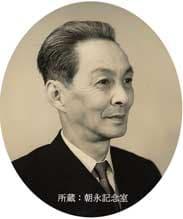About
Dr. TOMONAGA Sin-Itiro
Biography
- 1926-1929
- Department of Physics, Faculty of Science, Kyoto Imperial University (Dr. YUKAWA Hideki was a classmate)
- 1939
- Graduated with Ph. D. in Science from Kyoto Imperial University for research on nuclear materials
- 1941
- Became Professor of Tokyo University of Science and Literature
- 1949
- Became Professor of Tokyo University of Education
- 1956-1962
- President of Tokyo University of Education
- 1963-1969
- President of Science Council of Japan, Director of Institute of Optical Research, Tokyo University of Education
- 1969
- Became Professor Emeritus of Tokyo University of Education
- 1979
- Died on July 8.

Awards
- 1939
- Asahi Press Award:"Development of the mesonic theory and the super-many-time theory"
- 1948
- Japan Academy Prize: "Oscillation mechanism of magnetron"
- 1951
- Selected as a member of Japan Academy
- 1963-1969
- President of Science Council of Japan
- 1964
- Lomonosov Medal from the Academy of USSR for his contribution to physics
- 1965
- Nobel Prize for Physics
- 1976
- Grand Cordon of the Order of the Sacred Treasure
Research Works
Dr. TOMONAGA contributed to a broad range of theoretical physics, but his main works can be classified into the following four:
-
1.The super-many-time theory and renormalization theory
Quantum field theory, which explains the behavior of elementary particles, had a flaw that the relation of this theory with the theory of relativity was not entireily clear. Dr. TOMONAGA overcame this difficulty by introducing the super-many-time theory based on the idea that each point of space has its own specific time. Furthermore, the field theory of the electron and electro-magnetic fields, quantum electrodynamics, had an inherent contradiction that all calculated physical quantities became infinite. However, the super-many-time theory showed that each infinite term could be regarded as a correction to the mass and charge of electrons.
By renormalizing these infinities into the mass and charge of the electron, all physical quantities become finite, and thus the theory can explain experiments well. This is the renormalization theory of Dr. TOMONAGA. -
2. The theory of collective motions
Macroscopic matter contains approximately 10²² atoms per 1cm³, and these atoms exhibit not only random but also organized motion as a whole. These are called collective motions of many-body systems (e.g., acoustic waves in matter). Dr. TOMONAGA established a general method for dealing with many-body systems which can separate collective motions from random motions of atoms. This method is currently applied in many areas of theoretical physics.
-
3. The mesonic theory
According to the meson theory of Dr. YUKAWA, nucleons (protons and neutrons) in the atomic nuclei interact with a strong force called the nuclear force via mesons. Dr. TOMONAGA clarified the physical meaning of the meson theory by analyzing the mathematical structures of the theory, such as problems concerning the "field reaction" which mesons give to nucleons, and the method of intermediate coupling for less strong mutual interactions.
-
4. Magnetron and stereo-circuits
The theoretical work on the oscillation mechanism of the magnetron is very famous as an applied physics work done during the war. In particular, the theory of microwave stereo-circuits, which was constructed by analogy with an atomic nucleus reaction theory, put vitality into this then-stagnant field of electronics.


